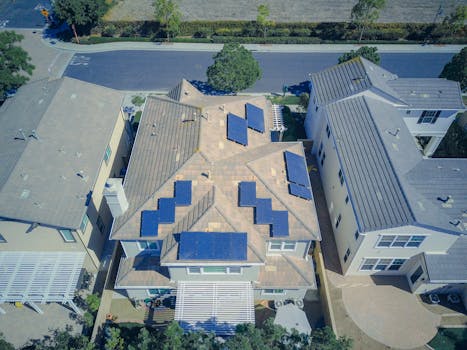“Empowering Solar Efficiency: Harnessing AI to Maximize Battery Performance.”
The integration of artificial intelligence (AI) in optimizing solar battery usage represents a significant advancement in renewable energy management. As the demand for sustainable energy solutions grows, AI technologies are being employed to enhance the efficiency and effectiveness of solar energy systems. By analyzing vast amounts of data from solar panels, weather patterns, and energy consumption, AI algorithms can predict energy production and consumption patterns, optimize battery charging and discharging cycles, and improve overall system performance. This not only maximizes the utilization of solar energy but also extends the lifespan of batteries, reduces costs, and contributes to a more reliable and resilient energy infrastructure. As the world shifts towards greener energy solutions, the role of AI in solar battery optimization is becoming increasingly crucial in achieving energy sustainability and efficiency.
Enhancing Energy Efficiency Through AI-Driven Solar Battery Management
The integration of artificial intelligence (AI) into solar battery management systems is revolutionizing the way we harness and utilize solar energy. As the demand for renewable energy sources continues to rise, optimizing the efficiency of solar batteries has become paramount. AI-driven technologies are playing a crucial role in enhancing energy efficiency, ensuring that solar power is not only generated but also stored and utilized in the most effective manner possible.
One of the primary ways AI enhances solar battery management is through predictive analytics. By analyzing historical data and real-time information, AI algorithms can forecast energy production and consumption patterns. This capability allows for more accurate predictions of when solar energy will be available and when it will be needed. For instance, during peak sunlight hours, AI can optimize the charging of batteries, ensuring they are fully charged when energy demand is high. Conversely, during periods of low sunlight, AI can manage the discharge of stored energy, ensuring that power is available when it is most needed. This dynamic management of energy flow not only maximizes the use of solar energy but also minimizes reliance on grid power, leading to significant cost savings.
Moreover, AI can enhance the longevity and performance of solar batteries through advanced monitoring and maintenance strategies. By continuously tracking the health and performance of batteries, AI systems can identify potential issues before they escalate into significant problems. For example, if a battery is showing signs of degradation, AI can recommend maintenance or replacement, thereby preventing unexpected failures. This proactive approach not only extends the lifespan of the batteries but also ensures that they operate at optimal efficiency, further contributing to energy savings.
In addition to predictive analytics and maintenance, AI can also facilitate smarter energy management at the grid level. By integrating solar battery systems with AI-driven grid management solutions, utilities can better balance supply and demand. AI can analyze data from multiple sources, including weather forecasts, energy consumption patterns, and grid conditions, to optimize the distribution of energy. This capability is particularly important in regions with high penetration of renewable energy sources, where fluctuations in energy generation can lead to instability in the grid. By leveraging AI, utilities can ensure a more reliable and efficient energy supply, ultimately benefiting consumers and the environment alike.
Furthermore, AI can enhance user engagement and energy management at the individual level. Smart home systems equipped with AI can provide homeowners with insights into their energy usage, allowing them to make informed decisions about when to use energy-intensive appliances or charge electric vehicles. By optimizing energy consumption based on real-time data, homeowners can reduce their energy bills and minimize their carbon footprint. This level of engagement not only empowers consumers but also contributes to a more sustainable energy ecosystem.
As the technology continues to evolve, the potential for AI in solar battery management is vast. Innovations such as machine learning and deep learning are paving the way for even more sophisticated energy management solutions. These advancements will enable systems to learn from past behaviors and adapt to changing conditions, further enhancing efficiency and reliability.
In conclusion, the role of artificial intelligence in optimizing solar battery usage is multifaceted and transformative. By leveraging predictive analytics, advanced monitoring, grid management, and user engagement, AI is enhancing energy efficiency in ways that were previously unimaginable. As we continue to embrace renewable energy sources, the integration of AI into solar battery management will be essential for maximizing the benefits of solar power, ensuring a sustainable and efficient energy future.
Predictive Analytics: AI’s Impact on Solar Battery Performance

Artificial intelligence (AI) is revolutionizing various sectors, and the renewable energy landscape is no exception. One of the most significant advancements in this field is the application of predictive analytics, which plays a crucial role in optimizing solar battery performance. By leveraging vast amounts of data, AI can forecast energy production and consumption patterns, thereby enhancing the efficiency and longevity of solar battery systems. This predictive capability is particularly vital in addressing the inherent variability of solar energy, which is influenced by factors such as weather conditions, time of day, and seasonal changes.
To begin with, predictive analytics utilizes historical data to identify trends and patterns in solar energy generation. By analyzing past performance metrics, AI algorithms can predict future energy output with remarkable accuracy. This predictive modeling allows for better planning and management of energy resources. For instance, if a forecast indicates a sunny day ahead, the system can optimize battery charging during peak sunlight hours, ensuring that excess energy is stored for later use. Conversely, if a cloudy day is anticipated, the system can adjust its operations to conserve battery life, thereby maximizing the overall efficiency of the solar energy system.
Moreover, AI-driven predictive analytics can enhance the integration of solar batteries with smart grid technology. As energy demand fluctuates throughout the day, AI can analyze real-time data to determine the optimal times for discharging stored energy. This not only helps in meeting consumer demand but also stabilizes the grid by reducing the reliance on fossil fuels during peak hours. By predicting when energy demand will spike, AI can facilitate a smoother transition between solar energy and traditional power sources, ultimately leading to a more resilient energy infrastructure.
In addition to optimizing energy usage, predictive analytics also plays a vital role in battery health management. Solar batteries, like all batteries, have a finite lifespan that can be affected by various factors, including charge cycles and temperature fluctuations. AI can monitor these variables in real-time, providing insights into the battery’s condition and predicting when maintenance or replacement may be necessary. This proactive approach not only extends the life of the battery but also reduces operational costs by preventing unexpected failures and downtime.
Furthermore, the integration of machine learning algorithms allows for continuous improvement in predictive accuracy. As more data is collected over time, AI systems can refine their models, leading to increasingly precise forecasts. This iterative learning process ensures that solar battery systems remain adaptable to changing environmental conditions and user behaviors. Consequently, the ability to predict energy production and consumption patterns becomes more sophisticated, enabling users to make informed decisions about energy usage and storage.
In conclusion, the role of artificial intelligence in optimizing solar battery usage through predictive analytics cannot be overstated. By harnessing the power of data, AI enhances the efficiency of solar energy systems, improves grid stability, and prolongs battery life. As the demand for renewable energy continues to grow, the integration of AI-driven predictive analytics will be essential in maximizing the potential of solar batteries. This technological synergy not only supports the transition to sustainable energy sources but also paves the way for a more efficient and resilient energy future. As we move forward, the collaboration between AI and renewable energy technologies will undoubtedly play a pivotal role in shaping a sustainable world.
Real-Time Monitoring: How AI Optimizes Solar Battery Lifespan
Artificial intelligence (AI) has emerged as a transformative force in various sectors, and its role in optimizing solar battery usage is particularly noteworthy. One of the most significant aspects of this optimization is real-time monitoring, which allows for enhanced management of solar energy systems. By leveraging AI technologies, users can gain insights into their solar battery performance, leading to improved efficiency and extended lifespan.
To begin with, real-time monitoring powered by AI enables continuous assessment of solar battery health and performance. Traditional monitoring systems often rely on periodic checks, which can overlook critical fluctuations in battery status. In contrast, AI systems can analyze data streams in real time, identifying patterns and anomalies that may indicate potential issues. For instance, if a battery is discharging faster than expected, AI algorithms can detect this deviation and alert users to investigate further. This proactive approach not only helps in addressing problems before they escalate but also ensures that the battery operates within optimal parameters.
Moreover, AI-driven monitoring systems can optimize charging cycles based on real-time data. Solar batteries are most efficient when charged and discharged at specific rates, and AI can analyze factors such as solar generation, energy consumption, and weather conditions to determine the best times for charging. By adjusting the charging schedule dynamically, AI can prevent overcharging or deep discharging, both of which can significantly shorten a battery’s lifespan. This intelligent management of charging cycles is crucial, as it maximizes the energy harvested from solar panels while minimizing wear and tear on the battery.
In addition to optimizing charging, AI can also enhance energy usage strategies. By analyzing historical data and current energy demands, AI systems can predict when energy consumption will peak and adjust battery usage accordingly. For example, if a household typically uses more energy in the evening, the AI can ensure that the battery is sufficiently charged during the day to meet this demand. This not only improves the efficiency of energy use but also reduces reliance on the grid, leading to cost savings for users.
Furthermore, the integration of AI with Internet of Things (IoT) devices amplifies the benefits of real-time monitoring. IoT sensors can collect vast amounts of data from solar panels and batteries, which AI can then process to provide actionable insights. This synergy allows for a comprehensive view of the entire solar energy system, enabling users to make informed decisions about their energy consumption and storage. For instance, if the AI detects that solar generation is lower than expected due to cloudy weather, it can recommend adjustments to energy usage or suggest alternative energy sources.
As the technology continues to evolve, the potential for AI in optimizing solar battery usage will only grow. Future advancements may include more sophisticated predictive analytics, allowing for even greater foresight in energy management. Additionally, as AI becomes more integrated into smart home systems, users will benefit from seamless automation that optimizes energy consumption without requiring constant manual intervention.
In conclusion, real-time monitoring through AI is revolutionizing the way solar batteries are managed. By providing continuous insights into battery performance, optimizing charging cycles, and enhancing energy usage strategies, AI not only extends the lifespan of solar batteries but also maximizes their efficiency. As we move towards a more sustainable energy future, the role of AI in solar energy systems will undoubtedly become increasingly vital, paving the way for smarter, more resilient energy solutions.
Integrating AI with Smart Grids for Improved Solar Battery Utilization
The integration of artificial intelligence (AI) with smart grids represents a transformative approach to optimizing solar battery usage, enhancing both efficiency and sustainability in energy management. As the world increasingly turns to renewable energy sources, the need for effective storage solutions becomes paramount. Solar batteries play a crucial role in this context, allowing for the storage of excess energy generated during peak sunlight hours for use during periods of low generation. However, the challenge lies in maximizing the efficiency of these batteries, and this is where AI comes into play.
AI technologies can analyze vast amounts of data generated by solar panels and battery systems, enabling real-time decision-making that optimizes energy storage and distribution. By employing machine learning algorithms, AI can predict energy production based on weather patterns, historical data, and current grid demands. This predictive capability allows for more informed decisions regarding when to store energy in batteries and when to release it back into the grid. Consequently, this not only enhances the efficiency of solar battery usage but also contributes to a more stable and reliable energy supply.
Moreover, integrating AI with smart grids facilitates better demand response strategies. Smart grids equipped with AI can dynamically adjust energy distribution based on real-time consumption patterns. For instance, during periods of high demand, AI can prioritize the release of stored solar energy, thereby reducing reliance on fossil fuel-based power sources. This not only optimizes battery usage but also supports the overall goal of reducing carbon emissions and promoting a cleaner energy landscape.
In addition to optimizing energy flow, AI can also enhance the maintenance and longevity of solar batteries. By continuously monitoring battery performance and health, AI systems can identify potential issues before they escalate into significant problems. Predictive maintenance, powered by AI, can alert operators to necessary interventions, ensuring that batteries operate at peak efficiency and reducing the risk of unexpected failures. This proactive approach not only extends the lifespan of solar batteries but also minimizes downtime, further contributing to the overall efficiency of solar energy systems.
Furthermore, the integration of AI with smart grids can facilitate the development of decentralized energy systems. In such systems, individual households or communities can generate, store, and manage their own solar energy. AI can optimize the interactions between these decentralized units, ensuring that energy is shared and utilized effectively. For example, during periods of excess generation, AI can direct surplus energy to neighboring homes or businesses that may require additional power, thereby maximizing the use of available resources and minimizing waste.
As the energy landscape continues to evolve, the role of AI in optimizing solar battery usage will only become more significant. The ability to harness data-driven insights for improved energy management not only enhances the efficiency of solar batteries but also supports the broader transition to renewable energy sources. By integrating AI with smart grids, we can create a more resilient and sustainable energy infrastructure that meets the demands of a growing population while minimizing environmental impact.
In conclusion, the synergy between artificial intelligence and smart grids is pivotal in optimizing solar battery utilization. Through predictive analytics, enhanced maintenance strategies, and the facilitation of decentralized energy systems, AI is revolutionizing the way we manage solar energy. As we move forward, embracing these technological advancements will be essential in achieving a sustainable energy future, ensuring that solar batteries are used to their fullest potential in the quest for cleaner, more efficient energy solutions.
Q&A
1. **Question:** How does artificial intelligence optimize the charging and discharging cycles of solar batteries?
**Answer:** AI algorithms analyze historical energy consumption patterns and solar generation data to determine the optimal times for charging and discharging, maximizing battery efficiency and lifespan.
2. **Question:** In what ways can AI predict energy demand for better solar battery management?
**Answer:** AI uses machine learning models to forecast energy demand based on factors like weather conditions, time of day, and user behavior, allowing for proactive management of battery resources.
3. **Question:** How does AI contribute to the integration of solar batteries with smart grids?
**Answer:** AI facilitates real-time data analysis and decision-making, enabling seamless communication between solar batteries and the smart grid, optimizing energy distribution and reducing grid strain.
4. **Question:** What role does AI play in enhancing the lifespan of solar batteries?
**Answer:** AI monitors battery health and usage patterns, providing insights for optimal charging practices and maintenance schedules, which can significantly extend the lifespan of solar batteries.
Conclusion
Artificial intelligence plays a crucial role in optimizing solar battery usage by enhancing energy management, improving predictive analytics for energy consumption, and facilitating real-time monitoring and control of battery systems. By analyzing vast amounts of data, AI algorithms can forecast energy production and demand, optimize charging and discharging cycles, and extend battery life. This leads to increased efficiency, reduced costs, and a more sustainable integration of solar energy into the grid, ultimately contributing to a more reliable and resilient energy system.




